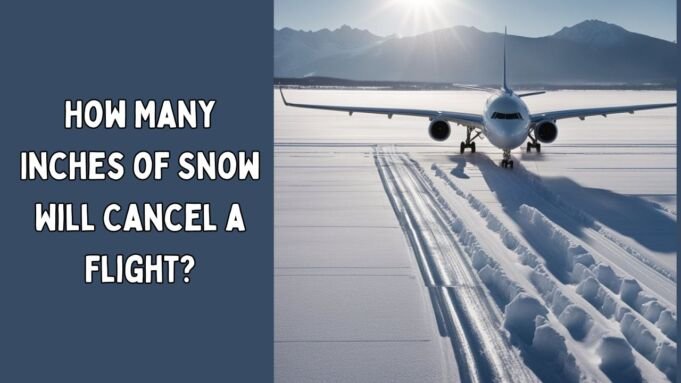Have you ever wondered how much snow it takes to cancel a flight? If you’ve experienced a flight cancellation due to snow, you know how frustrating it can be. Understanding the factors airlines consider when deciding whether to cancel a flight due to snow is essential.
In this blog post, I will answer the question of how many inches of snow will cancel a flight and provide a comprehensive guide to understanding the impact of snow on air travel.
How Does Snow Accumulation Influence Flight Cancellations?

The snow accumulation on the ground is one of the most critical factors airlines consider when deciding whether to cancel or delay flights. Generally, most airlines cancel flights when more than 10 inches of snow is on the ground. However, this can vary depending on the airline and the airport.
Typically, airports have their own rules for snow removal and de-icing, which can vary depending on the amount of snowfall and the time of day. For example, if only a few inches of snow are on the ground, the airport can clear it quickly and keep the runways open. If heavy snowfall or solid winds accompany the snow, it can be challenging to keep the runways clear, leading to flight cancellations or delays.
In some cases, airlines may cancel flights even if only a tiny amount of snow is on the ground. For example, Emirates Airlines has been known to cancel flights with minimal snowfall, occasionally less than 6 inches. This is because the airline prioritizes the safety of its passengers and crew, and it believes that it is better to cancel a flight than to risk the safety of its passengers.
Read: Spirit Airlines Child Wrong Flight
The Science Behind Snow’s Impact on Flights
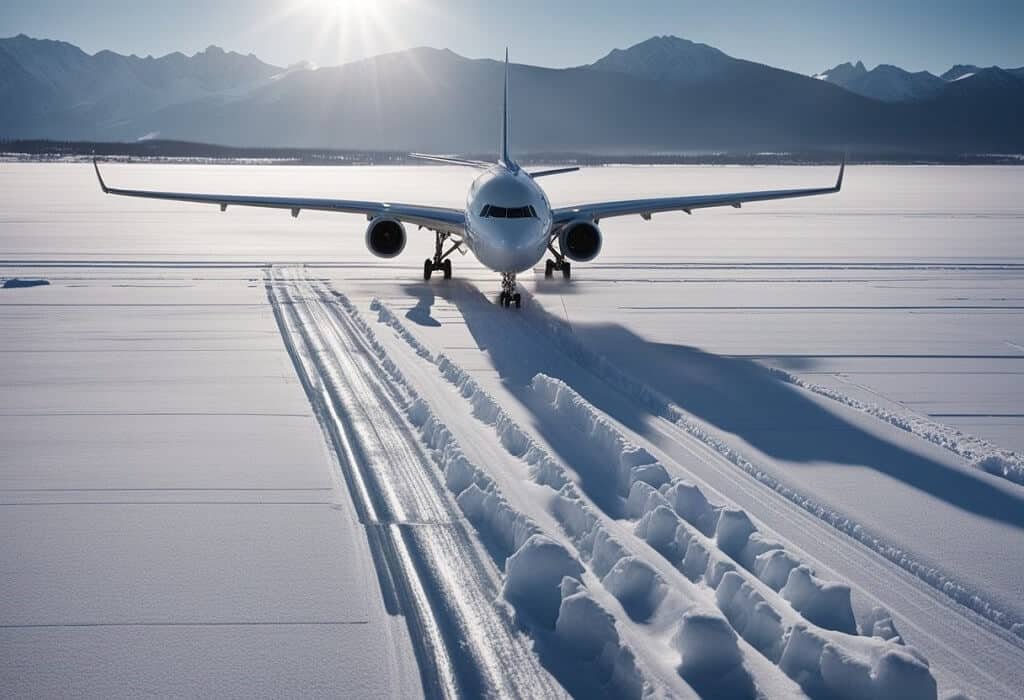
Snow can significantly impact flights, and it’s essential to understand the science behind it. When snow accumulates on runways, it can make them slippery and reduce the amount of traction for planes. This can make it difficult for planes to take off and land safely. Wet snow, in particular, can be a problem because it can freeze and turn into ice, making runways even more slippery.
Another factor to consider is the total snow accumulation. Heavy snow or snowstorms can lead to flight cancellations, as it can be challenging to keep up with clearing the runways. De-icing planes can also take time, and if there are too many planes to de-ice, it can cause delays and cancellations.
The forecast is also essential in determining whether flights will be canceled. If there is a high chance of heavy weather, airlines may cancel flights in advance to prevent any potential problems. Snowfall rates can also be a factor, as too much snow in a short time can make it challenging to keep up with clearing the runways.
In addition to snow, freezing rain can also cause problems for planes. It can make runways icy and decrease visibility, making it difficult for pilots to see. Wind gusts can also be a problem, as they can cause planes to veer off course and make landing and takeoff more difficult.
Airline Policies on Weather-Related Cancellations
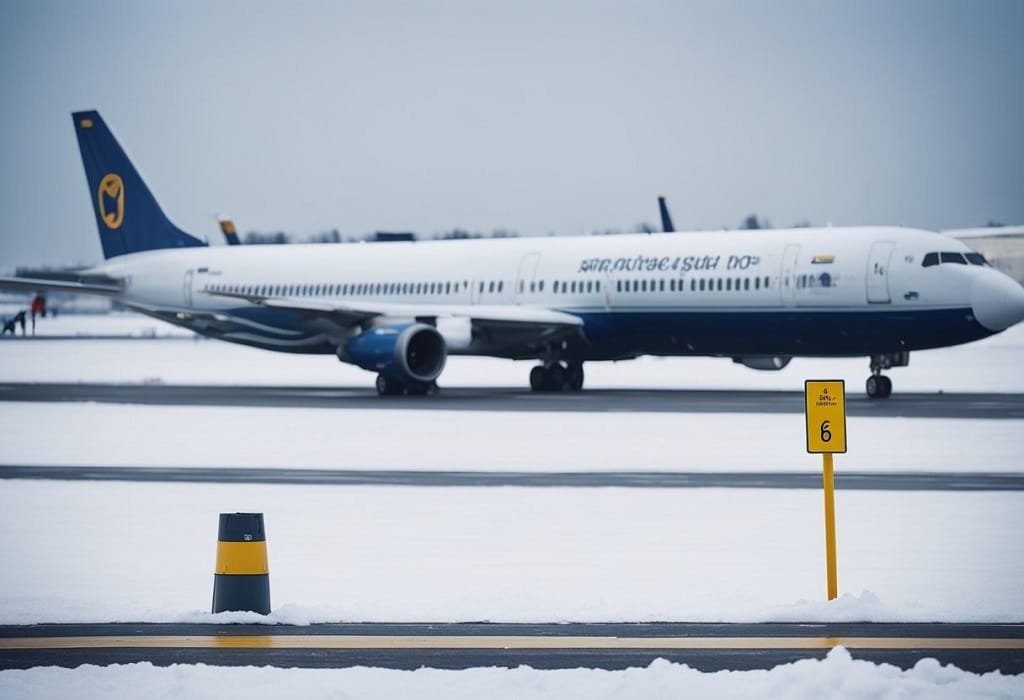
Many airlines have different policies when it comes to weather-related cancellations. Generally, airlines will cancel flights if over 10 inches of snow is on the ground. However, this can vary between airlines and airports. For example, Emirates may cancel flights even when minimal snowfall is sometimes less than 6 inches. Therefore, it is crucial to understand that different airports and airlines have rules for weather-related cancellations.
If you have a flight coming up and you are concerned about weather-related cancellations, contact the airline to find out their policy. Some airlines may allow you to rebook your flight for free, while others may charge a fee. It is important to note that airline policies can vary from airline to airline, so it is always best to check with the airline directly.
Regarding airline-to-airline policies, some airlines may have agreements to rebook passengers on each other’s flights in case of cancellations. This can be helpful if your airline cancels your flight and you must reach your destination immediately.
Read: What is the Cebu Pacific Cabin Crew Hiring Process?
Airport Snow Removal and Flight Continuity Planning
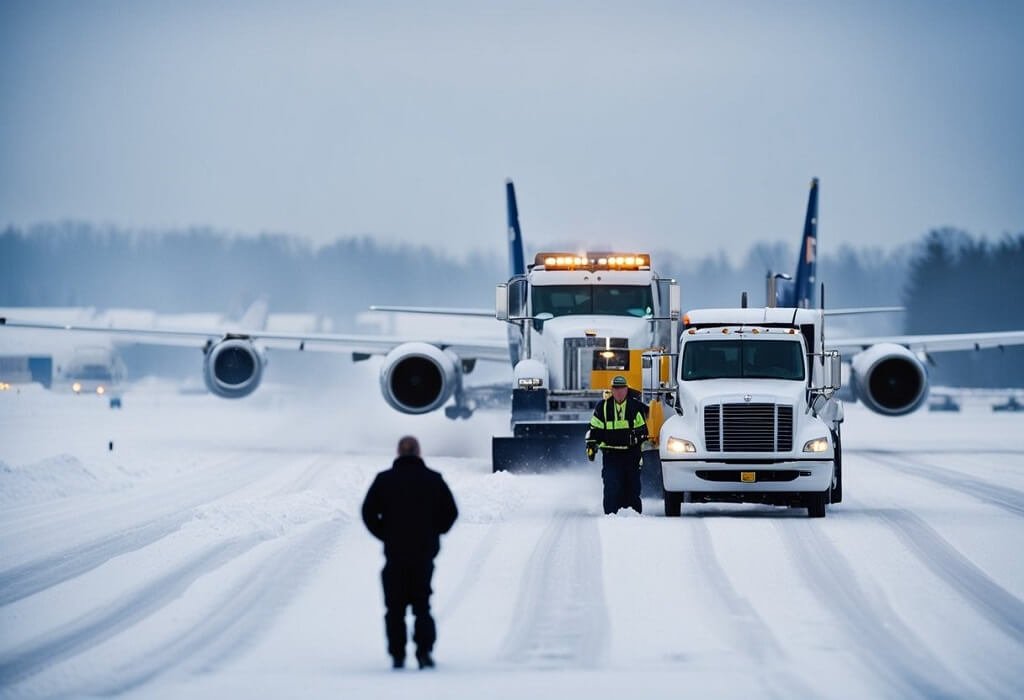
Every international airport has a snow removal plan, and ground crews are trained to keep runways and taxiways clear of snow and ice. However, even with the best efforts of airport staff, heavy snowfall can still delay or cancel flights.
Airlines have their flight continuity plans to deal with winter weather. They closely monitor weather conditions and use flight tracking systems to adjust schedules and routes. If a snowstorm is expected to hit, airlines may delay or cancel flights in advance to avoid disruptions.
De-icing equipment is also crucial to keep flights running smoothly in winter weather. Before takeoff, aircraft systems are treated with de-icing fluid to prevent ice buildup on the wings and other critical surfaces.
So, how much snow does it take to delay or cancel a flight? The answer is complex. While most airlines will cancel flights if there are more than ten inches of snow on the ground, the decision to delay or cancel a flight depends on many factors, including the amount of snow, the type of snow, and how it affects the ground and flight operation.
Regional Variability in Snow Preparedness
Different regions have different thresholds for canceling flights due to snow. For instance, Denver International Airport (DIA) is better equipped to handle snow than other airports that experience less frequent snowfall. According to the National Weather Service, DIA’s threshold for canceling flights due to snow is around 12 inches of snow accumulation.
However, other airports in regions that experience milder winters may cancel flights with as little as 2-3 inches of snow accumulation. For instance, airports in the southern United States may cancel flights due to snow, even if the accumulation is minimal. The threshold for canceling flights due to snow can also vary depending on the airport’s infrastructure and the region’s preparedness for snowstorms.
Moreover, temperatures hovering around freezing point can also impact the decision to cancel flights. In regions with temperatures below freezing, airports may be better equipped to handle snow and may only cancel flights if the accumulation is significant. However, in areas where temperatures are usually above freezing, even a tiny amount of snow accumulation can cause flight cancellations due to the lack of preparedness.
Read: Indigo Airline Interview Question and Answer
Technology’s Role in Mitigating Snow-Related Delays
Flights may get delayed or even canceled due to heavy snowfall, which can cause a significant inconvenience to passengers. However, with the help of modern technology, airlines and airports are better equipped to handle these situations and minimize delays.
One of the most essential tools in this regard is flight status tracking. Websites like FlightAware allow passengers to check the status of their flights in real time, which can help them plan their travel accordingly. This way, passengers can avoid getting stranded at the airport or wasting time waiting for a delayed flight.
Another way that technology helps mitigate snow-related delays is by allowing airlines to plan ahead of the storm. Using advanced weather forecasting technology, airlines can predict when a snowstorm is likely to hit and adjust their flight schedules accordingly. This way, they can avoid scheduling flights during the worst storm and minimize the impact on their passengers.
Additionally to these tools, airports also use specialized equipment to clear snow from runways and taxiways. This equipment includes snowplows, blowers, and de-icing trucks, which can quickly clear snow and ice from the runway and ensure safe takeoffs and landings.
Passenger Rights and Compensation in Case of Cancellations
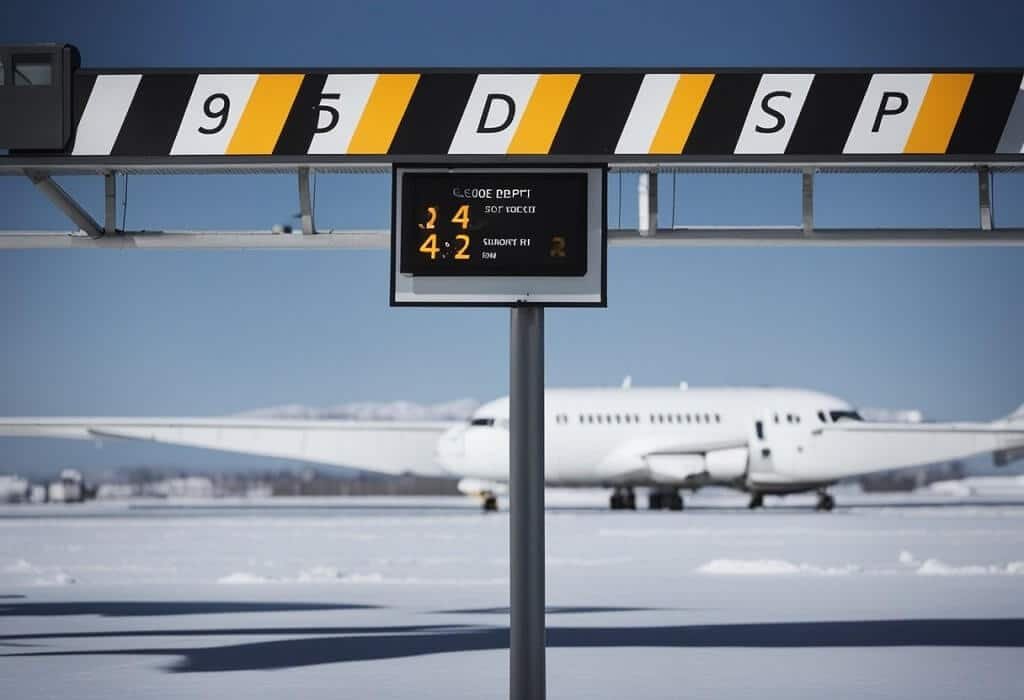
As a traveler, knowing your rights and compensation options is vital in case of flight cancellations. The amount of snow required to cancel a flight varies depending on the airline and airport. Some airlines may cancel flights with just a few inches of snow, while others may continue to operate in more severe weather conditions. In general, airlines prioritize passenger safety and will cancel flights if flying is unsafe.
If your flight is canceled due to bad weather or other reasons, the airline is typically not required to provide compensation. However, some airlines may offer compensation through meal vouchers, hotel accommodations, or rebooking on a later flight. You must check with your airline to see what options are available.
In cases where the cancellation is due to the airline’s fault, such as a mechanical issue or overbooking, passengers may be entitled to compensation under the airline’s policy or government regulations. For example, the U.S. Department of Transportation requires airlines to compensate passengers involuntarily bumped from a flight due to overbooking.
It is crucial to keep in mind that flight cancellations can disrupt your travel plans and cause inconvenience. If your flight is canceled, staying informed and proactively finding alternative travel arrangements is always a good idea. Check with your airline for rebooking options and consider alternative modes of transportation, such as trains or buses.
Read: Cebu Pacific Cabin Crew Requirements
Tips for Travelers Facing Winter Weather Disruptions
When traveling during winter, you should be prepared for potential flight delays and cancellations due to inclement weather. As someone who frequently travels in winter, you’ve likely picked up a few tips to help make the process smoother.
First and foremost, stay informed and stay updated. Check your airline’s website for the latest information on your flight, and sign up for text or email alerts. You can also download airline apps that will send you push notifications with updates on your flight status.
It is also essential to have a backup plan in case your flight is canceled. Check for other flights to your destination, or consider flying to another airport and renting a car to reach your destination. Southwest and United Airlines allow you to change your flight for free if traveling to or from certain cities during inclement weather.
When packing for your trip, include items that will help you stay comfortable in case of a delay. This can include a warm coat, hat, gloves, and a blanket. Packing snacks and a refillable water bottle in case you are stuck on the plane or in the airport for an extended period is also a good idea.
Lastly, be patient and understanding. Flight delays and cancellations are often due to unforeseen circumstances such as high winds or heavy snowfall. Remember that every plane and airport is different, and the decision to cancel a flight also depends on the airline’s and the airport’s policies. Stay calm, stay flexible, and remember that the safety of passengers is always the top priority.
Read: Delta Flight Attendant Salary
Frequently Asked Questions (FAQs)
How bad does the weather need to be for flights to be delayed?
The weather conditions that cause flight delays can vary depending on the airport and the airline. However, generally, flights can be delayed due to heavy rain, strong winds, fog, thunderstorms, and snow.
How much snow does it usually take to delay a flight?
The amount of snow that can delay a flight depends on factors such as the type of snow, the airport’s location, and the airline’s policies. Most airlines will cancel flights if more than ten inches of snow is on the ground. However, some airlines may cancel flights even if there is a small accumulation of snow, less than six inches.
What are the conditions for a school to cancel due to snow?
While this question is not directly related to flight cancellations, schools may cancel classes due to snow or other inclement weather conditions. The conditions for school cancellations due to snow may vary depending on the school district and the location. Typically, schools will close if the snow accumulation is too high or the roads are too dangerous for buses to travel.
How much snow would cancel a flight?
As mentioned earlier, the amount of snow that can cancel a flight depends on various factors, such as the type of snow, the airport’s location, and the airline’s policies. Most airlines will cancel flights if over 10 inches of snow is on the ground. However, some airlines may cancel flights even if there is a small accumulation of snow, less than six inches.
Is it possible for planes to take off with 3 inches of snow on the ground?
In some cases, planes can take off with a small amount of snow on the ground. However, deciding to take off or land an aircraft in snowy conditions is up to the pilot and air traffic control. If the runway is covered in snow, the pilots must use de-icing equipment to remove the snow and ice from the plane before takeoff.
Are planes capable of flying during snow storms?
Planes can fly during snowstorms, but it depends on the storm’s severity and the airline’s policies. Snow is not the only factor that can cause flight cancellations. Other factors, such as poor visibility, strong winds, and ice on the runway, can also affect the safety of a flight.
What is the threshold temperature for planes being too cold to fly?
The threshold temperature for planes being too cold to fly can vary depending on the airline and the type of plane. However, most commercial planes can operate at below -40 degrees Fahrenheit.
What should passengers expect if their flight is canceled because of snow?
If a flight is canceled due to snow, passengers should expect to be rebooked on another flight, either the same day or the next. They may also be offered a refund or a credit for future travel. It’s essential to check the airline’s policies regarding cancellations and rebooking.
How do I know if my flight will be canceled due to the weather?
In case you’re anxious about your flight being canceled due to bad weather, stay updated by checking the airline’s website or calling their customer support. Many airlines provide updates on flight changes through email or text notifications.
Are there chances of the flights being canceled?
Yes, there is always a chance that flights can be canceled due to weather or other unforeseen circumstances. It’s essential to check the airline’s policies regarding cancellations and rebooking and to have a backup plan in case of any flight disruptions.
Conclusion
The question of how many inches of snow will cancel a flight does not have a definitive answer. Most airlines will cancel flights if there is more than ten inches of snow on the ground, but this can vary between airlines and airports.
Other factors, such as the type of snow, accumulation, and regional preparedness, also play a significant role in flight cancellations. It’s essential to understand that different airports have rules for snow removal and de-icing procedures.
As a savvy traveler, it’s crucial to have contingency plans in place for dealing with winter-weather flight disruptions. Remember to check your airline’s policy on flight cancellations due to snow and stay informed about weather conditions in your destination. Safe travels!

